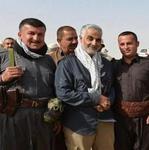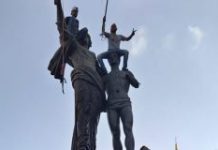The truth behind Iran’s supposed nuclear ties with Syria
Friday, 16 January 2015
Majid Rafizadeh/Al Arabiya
A new Western intelligence assessment points to efforts by the Syrian government to renew its operations in an underground and clandestine facility, close to Qusayr near the border of Lebanon, in order to produce nuclear weapons. Citing the Western intelligence assessment, the German weekly Der Spiegel stated that the reconstruction of the nuclear facility is being conducted with the assistance of the Islamic Republic, North Korea, and Hezbollah.
The report has led to a war of rhetoric among Western officials, outlets, along with Iranian and Syrian officials. The Western intelligence report indicates that dialogues among Ibrahim Othman, head of the Syrian Atomic Energy Commission, Iranian, North Korean and Hezbollah affiliates were “intercepted.” In addition, according Abu Mohammad al-Bitar, the Free Syrian Army has also noticed the “unprecedented” presence of Iranian and Hezbollah security members in the town of Qusayr on the suburbs of Homs.
Although one should be cautious about jumping to conclusions about Western intelligence reports, Iran-Syria or North Korean-Syria military and nuclear cooperation is not something new. The report rattled Iranian leaders, and Iran’s Foreign Minister Javad Zarif responded immediately by stating: “The magazine’s allegation is one of the attempts made by those circles whose life has been based on violence and fear to cloud the international community with illusion and create imaginary concerns about the Islamic Republic, and this is a ridiculous claim.” In addition, a Syrian source refuted the report and called it “mere lies.”
Although one should be cautious about jumping to conclusions about Western intelligence reports, Iran-Syria or North Korean-Syria military and nuclear cooperation is not something new; however, the reaction of Iranian and Syrian leaders have been different this time.
Iran-Syria nuclear cooperation? The fact that high Iranian officials responded immediately to the Western intelligence assessment refuting the report and calling it “ridiculous“ reflects the notion that the Rowhani administration’s attempts to exclude any efforts that might scuttle the nuclear negotiations between the six world powers (China, the United Kingdom, France, Germany, Russia and the United States) known as the P5+1 and the Islamic Republic.
Reports with respect to the Syrian government renewing its nuclear program were previously published in 2013. There had been reports that some activities were being carried out at an alleged Syrian nuclear facility close to eastern suburbs of Damascus, Marj Sultan. Nevertheless, Iranian leaders took the matter more seriously this time around.
Iranian and American chief diplomats will be meeting on Wednesday to find ways to speed up the nuclear negotiations and strike a final nuclear deal. According to Zarif, the reason behind these direct talks with American Secretary of State John Kerry “is to see if we can speed up and push the negotiations forward”
The Islamic Republic is attempting to show that it is complying with the International Atomic Energy Agency (IAEA) and the interim nuclear deal by restricting its uranium enrichment, not engaging in the international black market for obtaining nuclear material, and halting operation in its Plutonium reactor in Arak.
Syria’s nuclear program
In comparison to Iran’s sophisticated nuclear program, Syria’s nuclear program seems potentially nascent. There are two major nuclear sites in Syria. The first one is Al-Kibar reactor in the northeast of the city of Deir Azzor and the second one is Marj Sultan in the outskirts of Damascus- where the fuel is reportedly stored.
The International Atomic Energy Agency (IAEA) previously reported that Damascus was building a nuclear reactor in Deir Azzor. Reportedly, tons of enriched uranium in Damascus are being protected by Iran’s Revolutionary Guard Corps and Hezbollah.
This issue has resulted to heightened tensions between Israel and the Iranian-Syrian nexus as well. Formerly, Syrian nuclear site Al-Kibar reactor in the northeast of the city of Deir Azzor, was target of Israeli strikes in 2007, almost destroying the infrastructure and halting the program.
There are three common concerns about the undeclared Syrian nuclear site and nuclear proliferation. First of all, the argument is that the nuclear material might fall in the hands of the wrong side. In other words, if these nuclear sites are seized by some radical groups or al-Qaeda-linked affiliates, they might be capable of utilizing the highly enriched uranium and producing nuclear weapons.
Technically speaking though, the primary question is whether the 50 tons of uranium is natural or highly enriched to a level that can be transferred to nuclear warheads. In order to build nuclear weapons, weapons-grade highly enriched uranium or an adequate amount of centrifuges are needed.
The second question is whether the radical militants possess the capability of transferring Syria’s enriched uranium into weapon-grade bombs. But more fundamentally, Syria possess other military capabilities that can pose the same threat such as ballistic missiles and biological weapons. For example when it comes to the issues of ballistic missiles, Syria has previously cooperated with Iran and North Korea.
In addition, since Syria can hardly make an estimate of 50 tons of natural uranium, the role of other state and non-state actors is inevitable. Third, one can make the argument that without doubt, becoming a nuclear state for the Syrian government can be a formidable tool and deterrence against foreign intervention.
But more fundamentally, this report has diverted attention from Iran’s other indisputable and multi-layered activities and engagements in Syria- including the military, financial, intelligence, and advisory assistance to the Syrian government which have further radicalized and militarized the ongoing Syrian war.


















